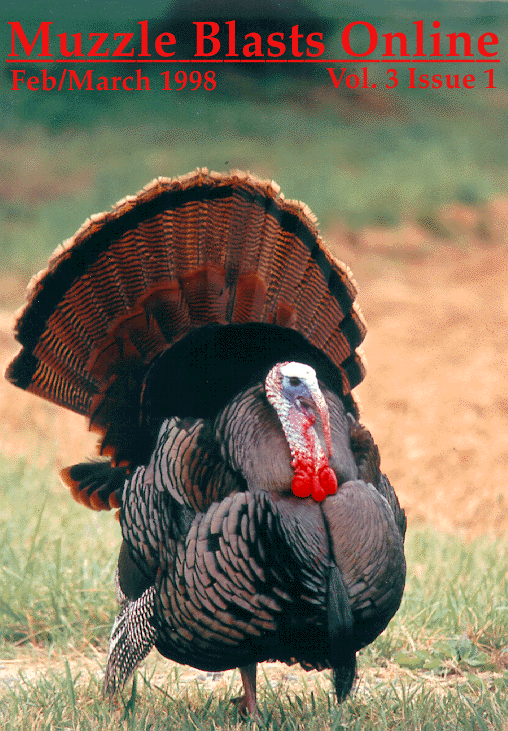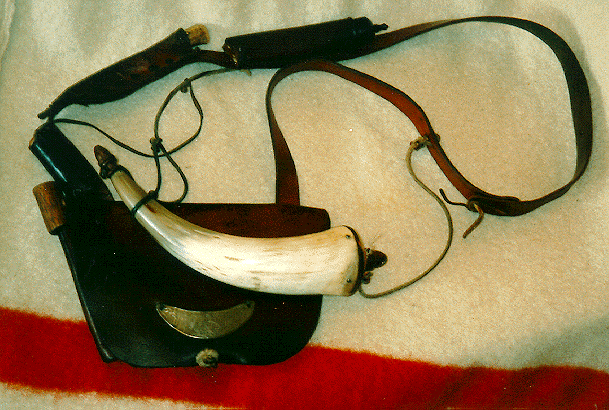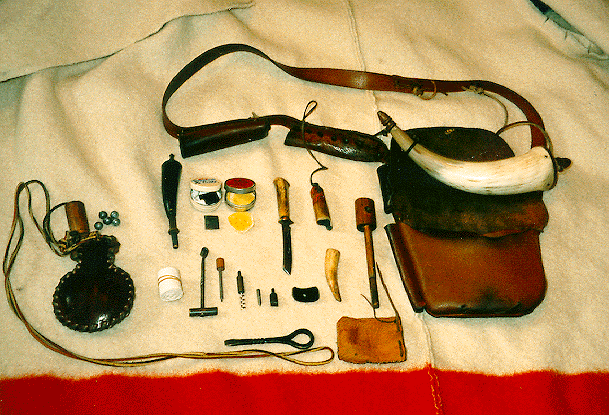|
Muzzle Blasts Online |
|
...for the muzzleloading enthusiast |
|
The muzzleblasts.com domain, subdomains, content, etc., are neither affiliated with the NMLRA nor its paper magazine Muzzle Blasts |
|
Muzzle Blasts Online |

|
|
|
|
|
|
The Shooting Pouch and Its Contents
I was lucky enough to get into muzzle loading when original rifles were still priced within the reach of a teen-age kid with only part-time employment. My first rifle, purchased through an ad in Muzzle Blasts and delivered by the U.S. Mule, set me back a whopping $27.50, plus postage. Having very limited knowledge of the ins-and-outs of shooting, I went to the local museums to see what kind of equipment the old-timers used.

|
|
The author's shooting pouch |
Then I drifted away from muzzle loading for a number of years, only to be lured back as the Buckskinning movement began. I acquired a new muzzle loader and started to rebuild the accoutrements needed for the sport. At shoots and rendezvous, I was amazed to see the size of the pouches being carried by those considered to be "hivernants" and the vast amount of "stuff" they seemed to think it necessary to tote. Many shooters struggled about with pouches the size of a musette bag, often double pocketed and crammed with a plethora of doo-dads. Never had I seen anything like them in the museums.
The shooters of the late muzzle loading period seemed to prefer a single-pouched bag of about 4" X 6" to no more than 6" X 9". The contents of the bags tended to be as sparse as the bags were small. Few even had internal pockets of any kind. The reason, I decided, for this stark simplicity probably lay in the fact that the men who originally owned these bags were primarily farmers and not Long Hunters or Mountain Men. Their shooting trips were mostly limited to short jaunts to put meat on the table--not journeys of many miles and weeks. I ditched that idea when I finally viewed a shooting pouch which had been owned by a certified, genuine Mountain Man. It too was a simple, small, single-pocketed pouch.
Having now carried a muzzle loader almost exclusively for several decades, I have pretty well settled on what is truly needed and what is flummery. If you just fell off of the turnip wagon and could use a little advice, or even if you've been shooting muzzle loaders since before dirt, read on. I'll share some of my thinking with you and, just maybe, you'll pick up a useful idea or two. Nothing here is engraved in stone and there is no requirement that you agree with me. It's just some low-calorie food for thought.

|
|
The author's shooting pouch contains everything he needs to successfully complete a competition. His bag is built to hang on the left side for comfort while on the trail. |
If you look at the photos which accompany this article, you'll notice that my pouch is built to hang on the left-hand side. I am not a south-paw, but there is a method to my madness. Unlike the pioneer pouches of my area, my shooting pouch has the horn hung integral with the bag, longhunter style. If it is worn on the right side, the side on which a right-hander carries his rifle, then the horn is always rubbing the inside of your elbow. Not comfy! The way mine is rigged, the horn and bag are out of the way on my left side and only a small ball-bag hangs on my right side. I can carry my rifle "in trail" for many hours without any arm irritation from friction with the horn, or muscle pain from holding it out at an unnatural angle to prevent rubbing. Also, when I carry the rifle in the crook of my left arm, the left forearm is supported by the horn. This puts part of the weight of the rifle onto my right shoulder, making it less tiring to carry. With my pouch slung this way, I can be the first man in line with my rifle muzzle pointing forward, or in the line with my muzzle pointing to the side, and not suffer any discomfort at all.
Also, in the longhunter style, I have my priming horn (with vent pick), patch knife, and powder measure all tucked away in little pockets on the bag strap. This way they do not swing about and get wrapped up in brush or fly up and perforate my nostrils when I am called upon to move rapidly. One of the most hilarious "shows" at rendezvous is when one of the people who have those little vent-pick-brush-knapping-hammer combo-tools, plus one or more powder measures hanging on a long bag strap, tries to run the Seneca. With everything flapping and flying, he looks like Ichabad Crane fleeing the Headless Horseman. I remember scoring a target on a Seneca Run a few years back. One shooter came bounding up and skidded to a stop, handed me his score card and set about loading his rifle. During the run from the last station, the thongs of his main horn, priming horn, powder measure, and combo-tool had gotten so tangled that he could hardly load. He ended up pouring powder into his palm and dumping it down the bore and priming with his main horn. (He hit his target but lost quite a bit of time). Things that flap about freely cause problems. I like things compact and neat.
The pouch in the photo is one I have carried for the last fifteen years or so. It is made out of medium weight cowhide and measures not quite nine inches wide by just under six inches deep. The flap is cut so that when closed, no water can run in. The straps are sewed onto the back with sinew and the joint is well oiled, as is the pouch. I have carried it in some real downpours without ever getting the contents wet. On the inside, there are two small pockets for carrying items. These allow you to find what you want without "fishing."
Let's look at some of the stuff I carry and discuss the reasons for carrying each item. In the photo showing all the items laid out, the gadget to the left of the pouch is my short starter. Short starters (straight starters) were found in olden times but were far from ubiquitous. The pioneers tended to use a looser patch/ball combination in their hunting loads than we do and thus did not need them. I use a .398" ball in a .403" bore with .017" drill patching. A short starter is a must, even with a coned muzzle. My starter is made from a short length of a TC Seneca ramrod which broke and was discarded by its owner, plus a short piece of an old hawk handle which died in a game of "Handles." It is light and small, does the job, and unlike those things with the big wooden ball, it does not get in the way. Many people, in my opinion, carry starters which are too long and cumbersome. You need only start the ball a few inches down the barrel.
The next item is a breech-plug face scraper. I carry it because I don't know what else to do with it. I have a modified Nock (patent) breech, so I don't have to worry about a build-up of crud in front of the touch-hole. Some folks swear by plug scrapers. I loan it out on occasion but have not needed to use it. (I've tried; there's just nothing there!)
To the left of the scraper is a ball puller. I carry it as defense against my own stupidity. With a Nock breech, if you dry ball, you need only trickle a little powder through the touch-hole and "Fooof!"--the ball is out. A ball puller is needed only if you dry ball on top of a breech full of oil. (A dumb move not unheard of).
Then comes the patch worm. This is a handy little item to have when cleaning on a rifle trail and the patch comes off in the bore. If your ramrod has a threaded hole on the end opposite the jag, this gadget can be screwed in, the patch pulled and the worm put away in no time at all. It is also nice to have along when you are in the boonies and can't run to your shooting box for help.
To the left of the patch puller are two of the most important items a flint shooter can carry: a knapping hammer and a knapping awl. (See "Shooting Flint", Muzzle Blasts, October 1990). The awl has a little lip on its shaft which is placed on the front of the flint. The top of the awl is then smacked with the hammer and a spawl is broken off of the flint. This is done along the face of the flint, returning its sharpness and taper. Don't leave home without this tool. (When lightening the load for a hunting trip, the knapping hammer is left out. Starting with a sharp flint, one will rarely have to knap while hunting. If I do, the screwdriver works well as a hammer when held by the blade-end).
Above the hammer and awl are two old percussion cap tins. One is used to carry a couple of spare flints. If you have two or three spares, the one in your rifle will last through a whole rendezvous. If the one in your gun is all you have-Yup! It'll die somewhere between the first and fifth shot.
The other tin has oiled shooting patches. When shooting a rifle trail, I lube with plain old spit. It is cheap and works as well as anything I've found. It ain't worth a ding though, if you have to leave your gun loaded a spell. For hunting, I use pure neat's-foot oil. (Not the neat's-foot compound.) It never hardens, dries out, freezes, or raises a stink. Also, unlike some of the commercial oiled patches, neat's-footed patches do not tend to catch fire. (Recently I've been using Ox-Yoke's 1,000 + lube. Good stuff!).
Below the knapping hammer is a ball block. I've tried all the plastic gadgets and such. They work fine. I just find that they answer a problem I don't have. When I hit a deer, it either goes down or it doesn't. If it does, a fast reload isn't needed. I reload normally and walk over to give the coup de grace, if needed. If the deer takes off running, there is no gadget which will allow you to load in time for a second shot. All you do is stuff nice dry powder into a fouled bore, where it will start drawing moisture. If you have done your part correctly, your deer will soon lie down and die. When you walk up on it after a wait for about 15 to 20 minutes, it should be past any thought of movement. A loaded gun is only insurance. However, if you cram a load down a dirty barrel and take off after that deer right away, you can keep a wounded deer going for a long time. You'll probably drive him into some other hunters. And if you do catch up to him, there is a good likelihood that you will have a hangfire or a total failure to fire. I carry a small bottle of alcohol in a shirt pocket. A patch wet with this will clean out the fouling and leave only a liquid that can be totally evaporated by quickly working a dry patch up and down the bore. A load put in after that is sure to go off. Take your time, clean your bore, wipe your pan, measure your powder, push a ball from your ball block down the bore, sit down, and eat a candy bar. Then go collect your venison. "Haste maketh waste!"
To the left of the can of spare flints is my priming horn. Yeh, I know, it is made of nauga horn. But it is such a dandy! It never plugs and gives excellent control over the powder flow. It's small and has touch-hole pick in the base. The perfect priming horn. Naturally, it is no longer in production.
Below the priming horn is a roll of patching, I simply cut off squares (there is nothing beneficial to having round patches) as I need them and wet them with saliva. This is a heavy double-weave drill which averages around eighteen thousandths of an inch in thickness. I purchase it by the yard from a national chain fabric store. Great stuff. I can use the same patch over and over again without burn-through or loss of accuracy. The store now claims to have never stocked that material and isn't interested in doing so. It's a crazy world.
Finally, on the far left is small ball pouch. With 25 to 30 balls in it, (enough for a full rifle trail) it shifts a goodly part of the weight of my accoutrements to my left shoulder, thus helping to balance the load. When hunting large game, where few shots will be fired, a filled ball block and a few extra balls go in the shooing pouch. Only then does this little item stay at home. Unlike some old timers, I do not like loose balls in the bottom of the bag. While frantically trying to grab a ball from among the items in my bag, I have rammed everything from a ball puller to slivers of old Jerky under my finger nails. I like a ball pouch.
You might ask "Where are the cleaning patches?" I keep them in the patch box of my rifle. They are cut from diaper material, and since they are dry, they do not soak my stock with oil. Storing them in the patch box also keeps the pouch neat.
There you have it. All the stuff you really need to carry and then some. You might add a strong thong to take a hitch around your cleaning rod and wrist as an aid in pulling a ball, if you make a habit of dry-balling and do not have a patent breech. That still leaves you room for a nice big sandwich, which is one of very best things to carry in a shooting pouch!
To the left of the short-starter lie two powder measures. The one with the thong holds 35 grains of 3F powder. This gives a 95-grain .40 caliber ball about 1450 fps out of a 36" barrel. Enough for shooting to about 75 yards without any major sight correction. The measure below it holds 45 grains and is carried tucked into one of the pockets in the shooting bag. This charge gives my rifle a muzzle velocity of just over 1650 fps and works well to about 120 yards--again without major sight correction. For large game hunting, or turkey and bear silhouettes, two of the small measures (70 grain) give a muzzle velocity of just over 2000 fps and this load is right on at 150 yards. A hold on the top of the bear's head at 200 yards brings a hit in the chest area. (But still does not always knock the *&#% thing over!)
To the left of the measures is my favorite patch knife. It is a bone-handled, Damascus-bladed dandy which was made by Dave "Wrinkled Finger" Twine, who was rash enough to put it on a blanket some years back. Nearly any small, sharp blade will do, but why just make do when you can cut your patches with a little gem like this one?
Under the short starter is a doe-skin pouch which holds the six items to its upper left. The first item immediately to the left of the pouch is a hand-forged screwdriver. It is not the best one I could find but it was cheap (I picked it off of a blanket at a shoot). It fits the rendezvous time period, is small enough to go in the pouch easily, and suffices for changing flints and removing the lock for cleaning.
Above the screwdriver, and to the left of the lower powder measure, is a spare leather flint-pad. This little item allows the jaws of the cock to grip the flint snugly without shattering the rock. One must always carry an extra of these. If you do, you'll never need it. If you don't, you'll drop yours the first time you change a flint while standing in high grass. That's as certain as dawn!